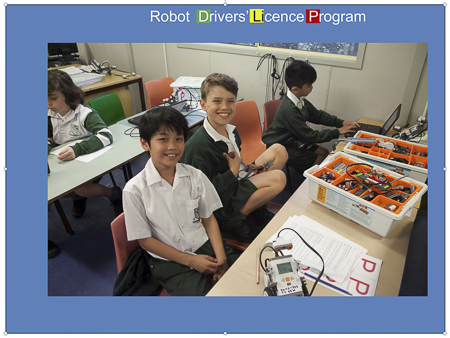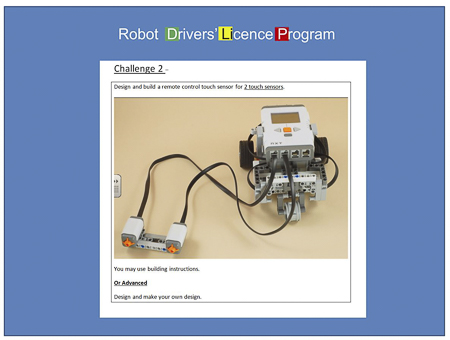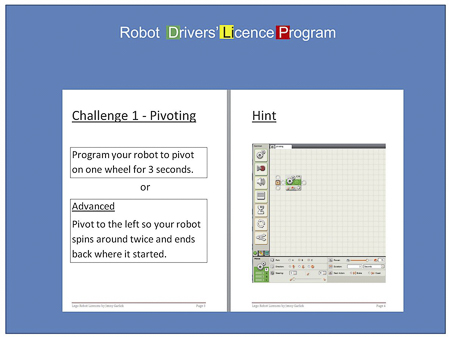Dear Bloggers,
As the recipient of the 2016 Australian Primary School, Lego Robotics Teacher Award, I presented my Drivers’ Licence Program at the Tufts University Lego Learning Symposium 2016. The focus of the conference was exploring new STEAM (Science,Technology, Engineering, Art and Mathematics) teaching methods for K – 12 education.
It is my hope that by sharing it with you, you will benefit in your own Lego Robotics education journey.
Download all the resources for the DLP program here
DLP Book 1 – Let’s Get Moving by Jenny Garlick
DLP Book 2 Using Sensors by Jenny Garlick
DLP Book 3 – Switches, My Blocks and more by Jenny Garlick
DLP licences and plates by Jenny Garlick
To begin my name is Jenny Garlick and I began teaching primary school Lego Robotics in 2006. I have a Bachelor of Science, a post graduate Diploma of Education and 28 years of teaching experience. For the last five years I have been teaching robotics to students aged 7 to 12 years at Gordon East Public School. This is a medium sized State Primary School with 345 students in Sydney, Australia. I teach in a classroom setting and focus on team work, engineering and open ended problem solving.
The Lego Robotics ‘Drivers’ Licence Program’ (DLP) is an innovative lego robotics program that I have developed and implemented over the past 18 months.
I modelled the program on the Australian Drivers’ licence system where drivers’ progress through a sequence of licences: Learner, Red Provisional licence, Green Provisional licence and finally a full licence.
Here is picture of my daughter with her Red P plates. 
This picture was taken a year later and shows her newly acquired Green P plates on the car.
Simarly in the classroom students take about 15 hours as they progress through this graduated system to achieve their open or full Robotics Drivers’ Licence when they have achieved mastery of all the required programming skills.
The Problem
Whilst teaching large classes of students in Year 5 and 6 how to program their NXT robots, many students had difficulty moving from explicit, highly structured, teacher directed lessons onto student centred learning.
How could one teacher do this and cater for the large range of abilities, needs and learning styles in a class of 30 students?
How could one person provide constant feedback and support to all pupils during a class?
The solution
The solution is the DLP, a student centred self-paced unit of work that aims to teach children 9 to 12 years old how to program their NXT robots.
Why is it so remarkable?
The remarkable success of the DLP is the delivery of highly differentiated lessons in the class room environment. With a ratio of 30 students to 1 teacher each pupil receives regular assessment, feedback, mentoring and recognition for their achievements. The DLP caters to a variety of learning styles and accommodates all levels of students with a mix of highly scaffolded basic exercises ranging to opportunities for extension.
The program has a high level of versatility and adaptability and can be easily used for other robots such as EV3, WeDo, RCX or any subject matter by simply slotting different activities into the DLP framework.
In my opinion, the greatest achievement of the program has been the incredible level of student success and engagement which has been achieved. I believe this type of approach would enhance student learning at any stage in any subject matter.
How exactly does it work?
The DLP consists of three stages each with a booklet that contains programming and building activities, check points, tick sheet and driving test.
The children work sequentially through the three booklets. The pages are well set out, clear, uncluttered and contain big clear colourful hints for inbuilt structural supports to facilitate a higher level of learning.
There are extension exercises throughout each booklet and the students choose whether they will carry these out. This way no one is pigeon holed into only doing advanced or regular tasks. Pupils, carrying out the regular activities, are provided with large amounts of scaffolding and can always see the advanced work so they are aware of what they are working towards. Other students may be able to achieve the advanced work because of the confidence and support the highly visual scaffolding provides. Students may fluidly move between the two levels depending on their ability and how confident they are feeling.
This use of Peer Mentoring is pivotal to the success of the program. At the completion of each challenge there is a check point and the team demonstrate and explain their work to their mentor team or ‘marking partner’. The marking partners check the challenge, troubleshoot if necessary, encourage the other team, provide constructive feedback and sign off the activity on the marking sheet. This will happen multiple times a lesson so their support and feedback is regular and ongoing. Children also have highly visible up to date records of their progress. Hence the teacher can see at any time where the team is up to and know the previous tasks have been successfully completed. This transparency and accountability is essential for the success of a self-paced unit.
At the successful completion of each stage students sit a ‘Driving Test’. There is an advanced and regular test and the students’ choose which test they will sit. The successful teams are awarded a badge -, ‘Red Ps’, ‘Green Ps’ and ultimately their ‘Full Licence’. These may be regular or advanced licences
The teacher marks the test and teams do not progress onto the next level until they have demonstrated mastery of the skills being tested. Additionally students receive a paper licence that provides a written summary of the programming and building skills achieved.
Students are required to display their plates on their robots. The robot plating, not only delights and engages the students but also ensures the teacher can visually asses what level each pair was working at (advanced or regular) and what section they are working on by just glancing around the room.
I will now show sample pages from each of the three stages and outline what each focuses on. Remember you can slot into the framework your own activities.
Stage 1 ‘Let’s get moving’ includes basic Robot Movements, Sounds, Displays and Parallel Sequence Beams. You can see a sample of a page of the workbook on the screen.
Stage 2 ‘Using Sensors’ covers using sensors.
Stage 3 – ‘Switches, My Blocks and Using the View menu’.
Once the complete Licence is gained, this is a gateway to further activities.
In summary the Drivers Licence Program
Is a framework for self-paced student centred learning that can be adapted to any subject providing a high level of student engagement, motivation and success.
The lessons are highly differentiated and cater to a variety of learning styles and accommodate all levels of students with a mix of highly scaffolded basic exercises ranging to opportunities for extension.
It involves a high level of peer assessment and mentoring with a highly motivating inbuilt reward system.



























